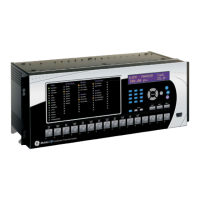CHAPTER 5: SETTINGS SYSTEM SETUP
T35 TRANSFORMER PROTECTION SYSTEM – INSTRUCTION MANUAL 5-151
5
Grounding [w] = SETTINGS SYSTEM SETUP TRANSFORMER WINDING w WINDING w GROUNDING
Φ[w] = SETTINGS SYSTEM SETUP TRANSFORMER WINDING w WINDING w ANGLE WRT WINDING 1
CT primary [w] = the phase CT primary associated with Source [w]
Note that w = winding number, 1 to w
total
The following transformer setup rules must be observed:
• The angle for the first winding from the transformer setup must be 0°, and the angles for the following windings must
be entered as negative (lagging) with respect to (WRT) the winding 1 angle
• The “Within zone” and “Not within zone” setting values refer to whether the winding is grounded. Select “Within zone”
if a neutral of a wye type winding, or a corner of a delta winding, is grounded within the zone, or whenever a
grounding transformer falls into the zone of protection.
5.5.4.4 Phase relationships of three-phase transformers
Power transformers that are built in accordance with ANSI and IEC standards are required to identify winding terminals
and phase relationships among the windings of the transformer.
ANSI standard C.37.12.70 requires that the terminal labels include the characters 1, 2, 3 to represent the names of the
individual phases. The phase relationship among the windings must be shown as a phasor diagram on the nameplate,
with the winding terminals clearly labeled. This standard states that the phase relationships are established for a condition
where the source phase sequence of 1-2-3 is connected to transformer windings labeled 1, 2, and 3 respectively.
IEC standard 60076-1 (1993) states that the terminal markings of the three phases follow national practice. The phase
relationship among the windings is shown as a specified notation on the nameplate, and there can be a phasor diagram.
In this standard, the arbitrary labeling of the windings is shown as I, II, and III. This standard states that the phase
relationships are established for a condition where a source phase sequence of I-II-III is connected to transformer
windings labeled I, II, and III respectively.
The reason the source phase sequence must be stated when describing the winding phase relationships is that these
relationships change when the phase sequence changes. The following example shows why this happens, using a
transformer described in IEC nomenclature as a type “Yd1” or in GE Multilin nomenclature as a “Y/d30.”
The example shows the physical connections within the transformer that produce a phase angle in the delta winding that
lag the respective wye winding by 30°. The currents in the windings are also identified. Note that the total current out of the
delta winding is described by an equation.
Figure 5-69: Example of transformer
Now assume that a source, with a sequence of ABC, is connected to transformer terminals ABC respectively. The currents
then present for a balanced load are shown in the following figure.

